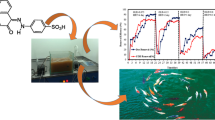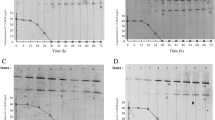Abstract
Large volumes of chlorinated aliphatic hydrocarbons are produced annually for a variety of industrial and commercial uses. They therefore constitute common contaminants of soil and groundwater causing serious environmental and human health problems. In this study, three bacteria were isolated from a pulp mill wastewater effluent in South Africa by culture enrichment technique and characterized for their ability to degrade 1,2-dichloroethane (1,2-DCE) and 1,3-dichloropropene (1,3-DCP). Specific growth rate constants of the organisms ranged between 0.864∼1.094 and 0.530∼0.585 d−1 in 1.2-DCE and 1,3-DCP, respectively, while the degradation rate constant of the compounds ranged variously between 0.33 and 1.006 d−1, with 1,2-DCE generally better utilized than 1,3-DCP. Gas chromatographic analysis revealed up to 75 and 80% removal of 1,2-DCE and 1,3-DCP, respectively, above that observed in the control bottles. These organisms also demonstrated high haloalkane dehalogenase activities with specific dehalogenase activities ranging between 0.25∼0.31 U (mg protein)−1. Analysis of their 16S rRNA gene sequences revealed that they belong to the generaPaenibacillus, Bacillus, andMicrobacterium.
Similar content being viewed by others
References
Hileman, B. (1993) Concerns broaden over chlorine and chlorinated hydrocarbons.Chem. Eng. News 71: 11–20.
Canter, L. W. and D. A. Sabatini (1994) Contamination of public ground water supplies by superfund sites.Int. J. Environ. Stud. 46: 35–57.
Mayer, A. S., P. P. E. Carriere, C. Gallo, K. D. Pennell, T. P. Taylor, G. A. Williams, and L. Zhong (1997) Groundwater quality.Water Environ Res. 69: 777–844.
Lee, M. D. and J. W. Davis (2000) Natural remediation of chlorinated organic compounds, pp. 199–245. In: M. Swindoll, R. G. Stahl, Jr., and S. J. Ells (eds.),Natural Remediation of Environmental Contaminants. Society of Environmental Toxicology and Chemistry. Pensacola, FL, USA.
Janssen, D. B., F. Pries, J. van der Ploeg, B. Kazemier, P. Terpstra, and B. Witholt (1989) Cloning of 1,2-dichlor-oethane degrading genes ofXanthobacter autotrophicus GJ10 and expression and sequencing of thedhlA gene.J. Bacteriol. 171: 6791–6799.
Poelarends, G. J. M., M. Wilkens, M. J. Larkin, J. D. van Elsas and D. B. Janssen (1998) Degradation of 1,3-dichloropropene byPseudomonas cichorii 170.appl. Environ. Microbiol. 64: 2931–2936.
McCarty, P. L. (1997) Microbiology—Breathing with chlorinated solvents.Science 276: 1521–1522.
Squillace, P. J., M. J. Moran, W. W. Lapham, C. V. Price, R. M. Clawges, and J. S. Zogorski (1999) Volatile organic compounds in untreated ambient groundwater of the United States, 1985–1995.Environ. Sci. Technol. 33: 4176–4187.
van den Wijngaard, A. J., R. D. Wind, and D. B. Janssen (1993) Kinetics of bacterial growth on chlorinated aliphatic compounds.Appl. Environ. Microbiol. 59: 2041–2048.
Baker, L. W., D. L. Fitzell, J. N. Seiber, T. R. Parker, T. Shibamoto, M. W. Poore, K. E. Longely, R. P. Tomlin, R. Propper, and D. W. Duncan (1996) Ambient air concentrations of pesticides in California.Environ. Sci. Technol. 30: 1365–1368.
Nouchi, T., H. Miura, M. Kanayama, O. Mizuguchi, and T. Takano (1984) Fatal intoxication by 1,2-dichloroethane—a case report.Int. Arch. Occup. Environ. Health 54: 111–113.
Spreafico, F., H. Tsuruta, T. Fujii, and A. E. Munson (1980) Pharmacokinetics of ethylene dichloride in rats treated by different routes and its long-term inhalatory toxicity.Banbury Reports 5: 107–129.
Janssen, D. B., A. Scheper, L. Dijkhuizen, and B. Witholt (1985) Degradation of halogenated aliphatic compounds byXanthobacter autotrophicus GJ10.Appl. Environ. Microbiol. 49: 673–677.
Janssen, D. B., S. Keuning, and B. Witholt (1987) Involvement of a quinoprotein alcohol dehydrogenase and an NAD-dependent aldehyde dehydrogenase in 2-chloroethanol metabolism inXanthomonas autotrophicus GJ10.J. Gen. Microbiol. 133: 85–92.
Castro, C. E. and N. O. Belser (1966) Hydrolysis of cis-and trans-1,3-dichloropropene in wet soil.J. Agric. Food Chem. 14: 69–70.
Roberts, T. R. and G. Stoydin (1976) The degradation of (Z)-and (E)-1,3-dichloropropenes and 1,2-dichloropropane in soil.Pestic. Sci. 7: 325–335.
Olaniran, A. O., D. Pillay, and B. Pillay (2004b) Aerobic dechlorination of cis- and trans-dichloroethenes by some indigenous bacteria isolated from contaminated sites in Africa.J. Environ. Sci. 16: 968–972.
Marchesi, J. R., T. Sato, A. J. Weightman, T. A. Martin, J. C. Fry, S. J. Hiom, D. Dymock, and W. G. Wade (1998) Design and evaluation of useful bacterium-specific PCR primers that amplify genes coding for 16S rRNA.Appl. Environ. Microbiol. 64: 795–799.
Altschul, S. F., T. L. Madden, A. A. Schäffer, J. Zhang, Z. Zhang, W. Miller, and D. J. Lipman (1997) Gapped BLAST and PSI-BLAST: a new generation of protein database search programs.Nucleic Acids Res. 25: 3389–3402.
Thompson, J. D., T. J. Gibson, F. Plewniak, F. Jeanmougin, and D. G. Higgins (1997) The ClustaIX windows interface: flexible strategies for multiple sequence alignment aided by quality analysis tools.Nucleic Acids Res. 25: 4876–4882.
Saitou, N. and M. Nei (1987) The neighbor-joining method: a new method for reconstructing phylogenetic trees.Mol. Biol. Evol. 4: 406–425.
Galtier, N., M. Gouy, and C. Gautier (1996) SEAVIEW and PHYLO_WIN: Two graphic tools for sequence alignment and molecular phylogeny.Comput. Applic. Biosci. 12: 543–548.
Jukes, T. H. and C. R. Cantor (1969) Evolution of protein molecules. pp. 21–132. In: H. N. Munro (eds.),Mammalian Protein Metabolism. Academic Press Inc., New York, NY, USA.
Felsenstein, J. (1993) PHYLIP (phylogeny inference package) version 3.5c. Department of Genetics. University of Washington, Seattle, USA.
Olaniran, A. O., D. Pillay, and B. Pillay (2004) Haloalkane and haloacid dehalogenases from aerobic bacterial isolates indigenous to contaminated sites in Africa demonstrate diverse substrate specificities.Chemosphere 55: 27–33.
Stucki, G., U. Krebser, and T. Leisinger (1983) Bacterial growth on 1,2-dichloroethane.Experientic 39: 1271–1273.
van den Wijngaard, A. J., K. W. van der Kamp, J. van der Ploeg, F. Pries, B. Kazemier, and D. B. Janssen (1992) Degradation of 1,2-dichloroethane byAncylobacter aquaticus and other facultative methylotrophs.Appl. Environ. Microbiol. 58: 976–983.
Verhagen, C., E. Smit, D. B. Janssen, and J. D. van Elsas (1995) Bacterial dichloropropene degradation in soil: screening of soils and involvement of plasmids carrying thedhlA gene.Soil Biol. Biochem. 27: 1547–1557.
Olaniran, A. O., D. Pillay and B. Pillay (2005) Characterization of two bacteria isolated from a wastewater treatment plant in South Africa for aerobic dehalogenation of some aliphatic chlorinated compounds.Int. J. Environ. Stud. 62: 59–68.
Tezuka, Y., N. Ishii, K.-I. Kasuya, and H. Mitomo (2004) Degradation of poly(ethylene succinate) by mesophilic bacteria.Polym. Degrad. Stab. 84: 115–121.
Zhang, H., A. Kallimanis, A. I. Koukkou, and C. Drainas (2004) Isolation and characterization of novel bacteria degrading polycyclic aromatic hydrocarbons from polluted Greek soils.Appl. Microbiol. Biotechnol. 65: 124–131.
Kulakova, A. N., M. J. Larkin, and L. A. Kulakov (1997) The plasmid-located haloalkane dehalogenase gene fromRhodococcus rhodochrous NCIMB 13064.Microbiology 143: 109–115.
Author information
Authors and Affiliations
Corresponding author
Rights and permissions
About this article
Cite this article
Olaniran, A.O., Naidoo, S., Masango, M.G. et al. Aerobic biodegradation of 1,2-dichloroethane and 1,3-dichloropropene by bacteria isolated from a pulp mill wastewater effluent in South Africa. Biotechnol. Bioprocess Eng. 12, 276–281 (2007). https://doi.org/10.1007/BF02931104
Received:
Accepted:
Issue Date:
DOI: https://doi.org/10.1007/BF02931104




